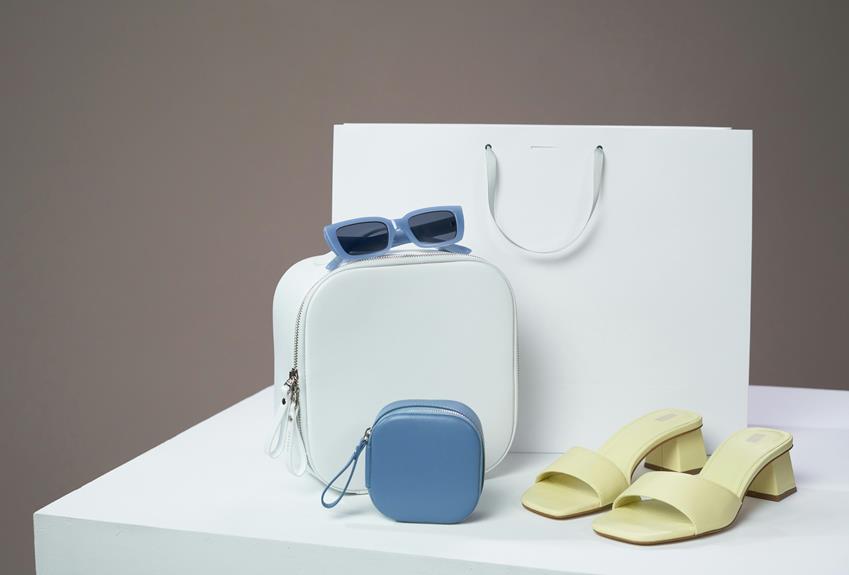When you're looking to enhance your bags and accessories with riveting, it's crucial to get the basics right. You'll want to start by selecting quality materials and matching rivets that fit your design. Precise placement is key, so measuring and marking your spots beforehand can save you from mistakes. As you work through your project, mastering the application techniques can make all the difference. But what happens when things don't go as planned? Let's explore some common issues and how you can troubleshoot them effectively.
Table of Contents
Key Takeaways
- Use high-quality materials like leather or canvas for durability and aesthetic appeal in your bags and accessories.
- Mark rivet placements carefully to ensure precision and symmetry before punching holes.
- Choose the appropriate size, shape, and finish of rivets to match your design and functionality needs.
- Apply even pressure with a rivet setter and hammer for secure and clean rivet installation.
Understanding Riveting Basics
Riveting, a technique that adds both style and durability to bags and accessories, involves securely fastening two or more materials together with metal fasteners. This method provides not only a strong bond but also an eye-catching detail that enhances the overall aesthetic of your items. Understanding the basics of riveting is essential if you want to elevate your craft.
To start, you'll need the right tools, including a rivet setter, a hammer, and, of course, the rivets themselves. Choose rivets that match the materials you're working with; the size and finish should complement your design. Once you've gathered your materials, mark the spots where you'll place the rivets. Precision is key, so take your time to ensure everything lines up perfectly.
After marking, you'll punch holes through the materials at the designated spots. Insert the rivets and use the setter to secure them in place. A firm, controlled strike with the hammer will create a strong hold.
Choosing the Right Materials
Selecting the right materials is key to achieving both the durability and aesthetic appeal you want in your bags and accessories.
Start by considering the fabric or leather you'll use. Look for materials that can withstand wear and tear, especially if you plan to use your bags frequently. High-quality leather, canvas, and synthetic options like nylon are excellent choices for their strength and longevity.
Next, think about the lining. A sturdy lining can enhance the overall durability and help avoid wear on the outer material. Cotton or polyester linings are popular for their resilience and ease of cleaning.
Don't forget to consider the weight of your materials. Heavier fabrics might add bulk, while lighter options can make your bags easier to carry.
Selecting the Perfect Rivets
When you're selecting rivets for your bags and accessories, consider how the materials will work together.
You'll want to think about the size and shape that best fits your design, as well as the color and finish that will enhance the overall look.
Making these choices can elevate your project and ensure everything comes together seamlessly.
Material Compatibility Considerations
To ensure durability and aesthetic appeal, you must choose rivets that complement the materials used in your bags and accessories.
Start by identifying the primary materials in your project—whether it's leather, canvas, or synthetic fabrics. Each material has specific characteristics that affect how rivets will perform.
For leather items, opt for brass or stainless steel rivets. They provide a classic look and resist tarnishing, enhancing the overall design.
If you're working with canvas, consider using aluminum rivets, which are lightweight and won't add unnecessary bulk. They're also available in various colors to match your fabric.
When using synthetic materials, such as vinyl, ensure the rivets have a smooth finish to prevent tearing or snagging. Look for rivets specifically designed for these materials, as they often have a softer grip to avoid damaging the fabric.
Lastly, always check the compatibility of the rivets with any hardware you plan to use. Mixing materials can lead to corrosion or wear over time.
Size and Shape Selection
Choosing the right size and shape of rivets is crucial for achieving both functionality and style in your bags and accessories. Start by considering the purpose of the rivets; larger rivets offer more strength, making them suitable for heavy-duty applications, while smaller rivets can enhance delicate designs without overwhelming them.
Next, pay attention to the shape. Common shapes include round, flat, and decorative rivets. Round rivets provide a classic look and are versatile enough for various projects. Flat rivets, on the other hand, sit flush against the surface, making them great for sleek designs. If you want to add a unique touch, decorative rivets come in various shapes and can serve as focal points.
Don't forget to think about the thickness of the material you're using. Choose rivets that match the thickness to ensure a secure fit. It's also wise to keep in mind how the rivets will interact with your overall design, aiming for a cohesive look that complements your bags and accessories.
Color and Finish Options
Selecting the right color and finish for your rivets can significantly enhance the overall design of your bags and accessories. The choice you make can either complement or clash with your materials, so it's crucial to think it through.
Here are four options to consider:
- Metallic Finishes: Choose from gold, silver, or bronze for a classic, elegant look. Metallics can add a touch of sophistication and work well with leather and canvas.
- Matte vs. Glossy: Matte finishes provide a subtle, modern vibe, while glossy finishes can create a bold, eye-catching effect. Decide based on the aesthetic you want to achieve.
- Colorful Rivets: Bright colors can add a playful element to your accessories. Think about using rivets in shades that match or contrast with your fabric for a fun twist.
- Antique or Vintage Finishes: These options can lend a rustic charm to your creations. They pair beautifully with distressed materials and can evoke a sense of nostalgia.
Preparing Your Project
Before diving into your riveting project, gather all necessary materials and tools to ensure a smooth and efficient process.
You'll need your rivets—choose the size and style that best suits your design—along with a sturdy surface to work on. A cutting mat can protect your workspace while providing a solid base for your project.
Next, grab a ruler or measuring tape for precise placement of your rivets. A pencil or fabric marker will help you mark your spots clearly.
Don't forget a hole punch or an awl to create holes for the rivets; having the right size is crucial for a snug fit. If you're working with thick materials, consider using a rotary punch for easier hole creation.
Also, have a hammer or a riveting tool ready to secure your rivets effectively. If you're using decorative rivets, check for any additional tools that may be necessary for installation.
Lastly, prepare your fabric or leather by ensuring it's clean and free from any debris. With everything in place, you're set to start your riveting project with confidence and precision.
Mastering Application Techniques
To achieve a professional look in your riveting project, mastering the right application techniques is essential.
You'll want to ensure that every rivet is securely placed for both durability and aesthetics. Here are four key techniques to help you excel:
- Mark Your Spots: Before you start, use a fabric marker to clearly mark where each rivet will go. This not only helps maintain symmetry but also prevents misplacement while working.
- Use the Right Tools: Invest in a quality rivet setter and a sturdy hammer. A good tool makes all the difference in achieving clean, well-seated rivets without damaging your material.
- Apply Even Pressure: When setting the rivets, apply even and firm pressure. This ensures that the rivet forms properly and secures your materials together effectively.
- Practice on Scrap Material: Before diving into your final project, practice on some scrap pieces. This will help you refine your technique and build confidence without risking your main materials.
Finishing Touches for Professionalism
To achieve a polished look in your bags and accessories, you need to focus on a few key finishing touches.
Choosing high-quality materials, ensuring proper alignment, and maintaining consistent riveting patterns can elevate your work from good to great.
Let's explore how these elements contribute to a professional finish.
Choose High-Quality Materials
Selecting high-quality materials is essential for elevating the overall professionalism of your bags and accessories. When you invest in superior materials, you not only enhance the visual appeal but also ensure durability and longevity.
Here are four key materials you should consider:
- Leather: Opt for full-grain or top-grain leather for a luxurious look and feel. These types resist wear and age beautifully.
- Canvas: Choose high-quality cotton or blended canvas for a sturdy yet stylish option. It's perfect for casual bags and adds a rugged touch.
- Hardware: Use solid metal rivets and clasps. They should be rust-resistant and durable to withstand regular use, adding an elegant touch to your design.
- Lining: Don't forget about the interior! A soft, durable lining can elevate your bag's quality and protect its contents.
Proper Alignment Techniques
Achieving proper alignment in your bags and accessories can significantly enhance their overall professionalism and visual appeal. To start, always measure and mark your desired positions for the rivets before you begin. Use a ruler or measuring tape to ensure that each rivet sits evenly and is spaced correctly.
Next, consider using a template. This can help you maintain consistent placement across multiple pieces. If you're working on a larger project, create a guide that outlines where each rivet should go. This way, you won't have to guess, and you'll avoid any misalignment.
When you're ready to attach your rivets, double-check their positioning before securing them. It's easier to make adjustments at this stage than to fix them after they're installed. If you find any discrepancies, don't hesitate to pull out the rivet and reposition it.
Lastly, always work on a flat, stable surface. This minimizes movement and keeps everything aligned during installation.
Consistent Riveting Patterns
Consistently using riveting patterns not only enhances the visual appeal of your bags and accessories but also elevates their overall professionalism. When your riveting is well-organized, it gives your pieces a polished look that stands out.
Here are some tips to help you establish a consistent riveting pattern:
- Choose a Layout: Decide on a specific layout, such as straight lines, grids, or diagonal patterns, before you start riveting. This will guide your placement and ensure uniformity.
- Measure Distances: Use a ruler or measuring tape to determine the spacing between rivets. Keeping equal distances will create a balanced look.
- Mark Positions: Lightly mark where each rivet will go. This helps you visualize the final design and prevents mistakes during the riveting process.
- Maintain Orientation: Always position your rivets in the same direction. Whether you prefer them facing up or down, consistency in orientation adds to the professionalism of your work.
Troubleshooting Common Issues
When you encounter issues with riveting on bags and accessories, identifying the specific problem is the first step to finding an effective solution.
Common issues include misaligned rivets, which can often be fixed by carefully measuring and marking your placement before you start. If you're dealing with weak rivets that pull through the material, check that you're using the right size and type of rivet for your fabric thickness.
If your rivets are cracking or breaking, it could be due to applying too much pressure during installation. Try using a lighter touch and ensure your tools are in good condition. Also, inspect your materials; some fabrics simply aren't strong enough for certain rivet styles.
Another frequent issue is rusting, particularly with metal rivets. To prevent this, use rust-resistant rivets or apply a protective coating before riveting.
Lastly, if you notice that your rivets don't hold well after installation, consider reinforcing the area with a patch or double-layering the fabric.
Frequently Asked Questions
Can I Use Rivets on All Types of Fabric?
You can't use rivets on all fabric types. While sturdy materials like denim or leather work well, delicate fabrics might tear. Always test a small area first to ensure it holds without damaging the fabric.
How Do I Remove a Rivet Without Damaging the Material?
To remove a rivet without damaging the material, you can use a pair of pliers to grip the rivet and gently twist it. If needed, use a small cutting tool to carefully slice around it.
Are There Specific Rivet Sizes for Different Bag Styles?
Yes, there are specific rivet sizes for different bag styles. You'll want to consider the bag's material and design. Larger bags often require bigger rivets, while smaller designs benefit from more delicate, smaller rivets.
What Tools Are Essential for Beginners in Riveting?
To start riveting, you'll need a riveting tool, a hammer, a cutting mat, and rivets. You might also want pliers for better grip and a marking tool to ensure precise placement. It's that simple!
How Can I Incorporate Rivets Into Existing Designs Creatively?
You can creatively incorporate rivets by adding them to seams, using them as decorative accents, or creating unique patterns. Experiment with sizes and finishes to enhance your designs and give them a fresh, personalized look.
- How Does Ring Spun Cotton Affect Garment Fit and Shape Retention? - August 13, 2024
- What Are the Challenges in Producing Ring Spun Cotton? - August 13, 2024
- Is Ring Spun Cotton Suitable for Plus-Size Clothing? - August 13, 2024







